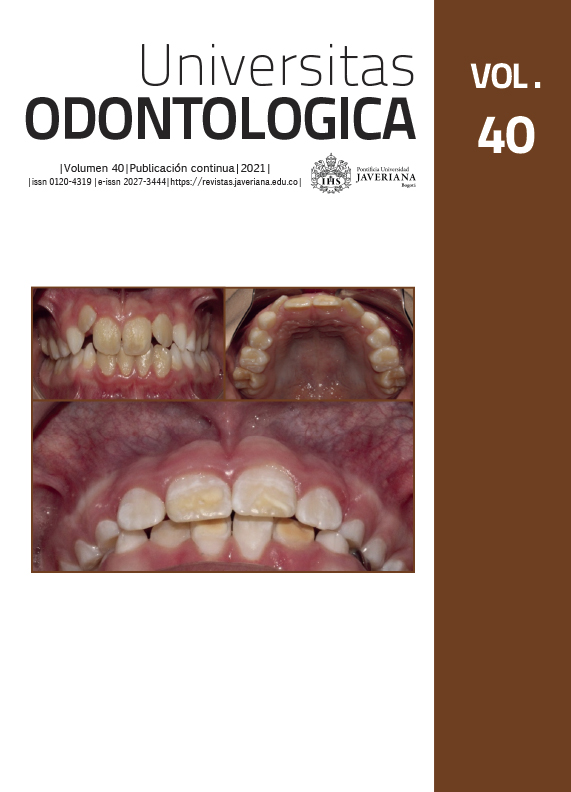Resumo
Antecedentes: A síndrome de Down é a condição genética mais prevalente entre as pessoas com deficiência. Diante do aumento da expectativa de vida desses pacientes, é importante melhorar suas condições gerais e de saúde bucal na vida adulta. Nessa fase do ciclo de vida, somam-se à sua condição efeitos do envelhecimento como perda de massa muscular, força e coordenação, que também impacta o sistema estomatognático e provoca alterações em funções vitais como deglutição e mastigação. Objetivo: Explorar e descrever as características das funções orofaciais de deglutição e mastigação em adultos com síndrome de Down. Métodos: Foi realizada busca de títulos nas bases de dados PubMed, LiLACS e SciELO. Os termos e operadores booleanos utilizados foram (síndrome de down) AND (distúrbios alimentares); (síndrome de down) AND ((distúrbios da deglutição) OR (disfagia)); e (síndrome de down) AND ((distúrbios da mastigação) OR (disfunção mastigatória)). Resultados: A busca resultou em 82 artigos e, após a realização de um processo de seleção, 11 artigos foram incluídos para elaboração da revisão. Conclusões: Adultos com síndrome de Down apresentam características anatômicas e funcionais que afetam os processos de mastigação e deglutição. Da mesma forma, as características dos alimentos também podem influenciar no desempenho de ambas as funções orofaciais. Recomenda-se estudar, em pesquisas futuras, as perspetivas dos pais ou cuidadores sobre a deglutição e mastigação de adultos com síndrome de Down para determinar como influenciam o processo de alimentação e identificar as ações que realizam para facilitar esse processo.
Presson AP, Partyka G, Jensen KM, Devine OJ, Rasmussen SA, McCabe LL, McCabe ER. Current estimate of Down Syndrome population prevalence in the United States. J Pediatr. 2013 Oct; 163(4): 1163-1168. https://dx.doi.org/10.1016/j.jpeds.2013.06.013
Nazer H J, Cifuentes O L. Malformaciones congénitas en Chile y Latino América: una visión epidemiológica del ECLAMC del período 1995-2008. Rev Med Chile. 2011 Jan; 139(1): 72-78.
Glasson EJ, Dye DE, Bittles AH. The triple challenges associated with age-related comorbidities in Down syndrome. J Intellect Disabil Res. 2014 Apr; 58(4): 393-398. https://dx.doi.org/10.1111/jir.12026
Hawkins BA, Eklund SJ, James DR, Foose AK. Adaptive behavior and cognitive function of adults with down syndrome: modeling change with age. Ment Retard. 2003 Feb; 41(1): 7-28. https://dx.doi.org/10.1352/0047-6765(2003)041<0007:ABACFO>2.0.CO;2
Head E, Lott IT, Wilcock DM, Lemere CA. Aging in Down Syndrome and the Development of Alzheimer's Disease Neuropathology. Curr Alzheimer Res. 2016; 13(1): 18-29. https://dx.doi.org/10.2174/1567205012666151020114607
Lazenby T. The impact of aging on eating, drinking, and swallowing function in people with Down's syndrome. Dysphagia. 2008 Mar; 23(1): 88-97. https://dx.doi.org/10.1007/s00455-007-9096-1
Prasher VP, Metseagharun T, Haque S. Weight loss in adults with Down syndrome and with dementia in Alzheimer's disease. Res Dev Disabil. 2004 Jan-Feb;25(1): 1-7. https://dx.doi.org/10.1016/j.ridd.2003.04.005
Hennequin M, Faulks D, Veyrune JL, Bourdiol P. Significance of oral health in persons with Down syndrome: a literature review. Dev Med Child Neurol. 1999 Apr; 41(4): 275-283. https://dx.doi.org/10.1017/s0012162299000596
Hashimoto M, Igari K, Hanawa S, Ito A, Takahashi A, Ishida N, Koyama S, Ono T, Sasaki K. Tongue pressure during swallowing in adults with down syndrome and its relationship with palatal morphology. Dysphagia. 2014 Aug; 29(4): 509-518. https://dx.doi.org/10.1007/s00455-014-9538-5
Smith CH, Teo Y, Simpson S. An observational study of adults with Down syndrome eating independently. Dysphagia. 2014 Feb; 29(1): 52-60. https://dx.doi.org/10.1007/s00455-013-9479-4
Zárate N, Mearin F, Hidalgo A, Malagelada JR. Prospective evaluation of esophageal motor dysfunction in Down's syndrome. Am J Gastroenterol. 2001 Jun; 96(6): 1718-1724. https://dx.doi.org/10.1111/j.1572-0241.2001.03864.x
Allison PJ, Peyron MA, Faye M, Hennequin M. Video evaluation for mastication validation in persons with Down's syndrome. Dysphagia. 2004 Spring; 19(2): 95-99. https://dx.doi.org/10.1007/s00455-003-0506-8
Hennequin M, Mazille MN, Cousson PY, Nicolas E. Increasing the number of inter-arch contacts improves mastication in adults with Down syndrome: a prospective controlled trial. Physiol Behav. 2015 Jun 1; 145: 14-21. https://dx.doi.org/10.1016/j.physbeh.2015.03.034
Thacker A, Abdelnoor A, Anderson C, White S, Hollins S. Indicators of choking risk in adults with learning disabilities: a questionnaire survey and interview study. Disabil Rehabil. 2008; 30(15): 1131-1138. https://dx.doi.org/10.1080/09638280701461625
Chenbhanich J, Wu A, Phupitakphol T, Atsawarungruangkit A, Treadwell T. Hospitalisation of adults with Down syndrome: lesson from a 10-year experience from a community hospital. J Intellect Disabil Res. 2019 Mar; 63(3): 266-276. https://dx.doi.org/10.1111/jir.12572
Bermudez BEBV, de Oliveira CM, de Lima Cat MN, Magdalena NIR, Celli A. Gastrointestinal disorders in Down syndrome. Am J Med Genet A. 2019 Aug; 179(8): 1426-1431. https://dx.doi.org/10.1002/ajmg.a.61258
Pinheiro DLDSA, Alves GÂDS, Fausto FMM, Pessoa LSF, Silva LAD, Pereira SMF, Almeida LNA. Effects of electrostimulation associated with masticatory training in individuals with down syndrome. Codas. 2018; 30(3): e20170074. https://dx.doi.org/10.1590/2317-1782/20182017074
Hennequin M, Allison PJ, Faulks D, Orliaguet T, Feine J. Chewing indicators between adults with Down syndrome and controls. J Dent Res. 2005 Nov; 84(11): 1057-1061. https://dx.doi.org/10.1177/154405910508401117
Mazille MN, Woda A, Nicolas E, Peyron MA, Hennequin M. Effect of occlusal appliance wear on chewing in persons with Down syndrome. Physiol Behav. 2008 Mar 18; 93(4-5): 919-929. https://dx.doi.org/10.1016/j.physbeh.2007.12.010

Este trabalho está licenciado sob uma licença Creative Commons Attribution 4.0 International License.
Copyright (c) 2022 Lorena Ester Sepúlveda Vega, Pablo Méndez, Patricia Vázquez Fernández


